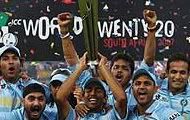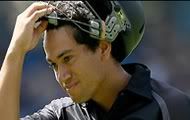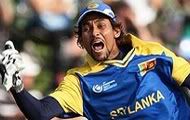
A match that began with a celebration of Sachin Tendulkar, ended with a celebration by Sachin Tendulkar. But like for much of his life, the celebration of him was loud, unending and rapturous while the celebration by him was animated, brief and not over the top. Tendulkar had combined with Gautam Gambhir to keep Sri Lanka at bay and earn a draw for India, on a pitch that was a bad advertisement for Test cricket. Both Tendulkar and Gambhir scored centuries - bringing the the total number of centuries in the match to seven - but their knocks were more about their mind conquering their impulses than their mind and skills conquering the bowlers and the conditions.
India began the day, trailing by 144 runs, and ended it leading by 78. In between, Sri Lanka picked up the wickets of nightwatchman Amit Mishra and centurion Gautam Gambhir.
Mishra and Gambhir had ended Day 4 well for India, with Mishra displaying decent batting talent. He continued the good work in the morning, while Gambhir looked like he had set himself up to bat throughout the day. Mishra had progressed to 24, when he flicked Angelo Mathews off his pads for a good-looking shot, only to see Dilshan come in between the ball and its intended course towards the boundary. It was a brilliant reflex catch, and was so unexpected that Mishra actually stood for a while in disbelief. However, this innings would have not only given him the confidence to bat in future Test matches, but it will also be a valuable, though subtle, confidence boost in the minds of the established batsmen who will now know that Mishra can be relied upon to hang around if they find themselves batting with him towards the end of an innings.
After Mishra's fall, Tendulkar walked out to the crease to join Gambhir. On a road of a pitch, Tendulkar and Gambhir eschewed any risks, but didn't pull down the shutters altogether and kept the scoreboard moving. They took India to lunch, still trailing Sri Lanka by 78 runs, but with no threat to losing their wickets if they kept their heads. Gambhir had reached his seventh Test century in the first session, displaying an uncanny ability to lift his game when his team needed him the most. This was his 6th century in his past 8 Test matches, underlining the rich vein of form he has been in during the past year and more. This was also the fourth time Gambhir had made a century in his second innings during a Test match. In fact, Gambhir's average in the second innings of all Test matches he has played went up to an astounding 63.67. Taken in conjunction with a very good first innings average of 48.70, it tells you just why Gambhir has been so valuable for India at the top of the order.
However, after lunch, Gambhir momentarily lost his cool and had to pay for it with his wicket. He charged down the track to Rangana Herath and, much like his friend and opening partner Sehwag, ended up giving a dolly to mid-off. Gambhir had done his job though and played a large part in taking India to safety. After Gambhir departed for 114, the old warhorses - Laxman and Tendulkar - got together and their partnership was unbroken till the end of the match. The final day's play had been in stark contrast to the frantic run-gathering of the previous four days, but at no stage did either Laxman or Tendulkar look discomfited. They took India's total past the deficit-mark of 334, and progressed serenely towards their respective individual landmarks - Laxman to his fortieth half-century and Tendulkar to his forty third century.
As Tendulkar reached the nineties, Sangakkara changed bowling tactics, with all the bowlers bowling negative lines. However, Tendulkar was equal to the task, once turning a ball from miles outside off-stump to the square-leg boundary, and once stroking the ball through a packed off-side cordon for another boundary. He reached his century with a scampered single off Welegedera, and had an animated but brief celebration. The match was then called off at the end of the over, with Tendulkar unbeaten on 100 and Laxman on 51.
It is worth noting that but for the brief burst from Welegedera on the first morning, there was nothing in the pitch for the bowlers. The Indian cricket administrators have consistently maintained that they want to uphold the purity and sanctity of Test cricket, and they are not merely looking to cash in on the popularity of the limited-overs formats. However, with pitches like these, it is the surest way of killing interest in Test cricket. This pitch would have been great for an ODI or a Twenty20 match with the likelihood of big scores from both sides. But for a Test match, that demands an equal battle between bat and ball to be compelling, it was a disaster. There were almost 1600 runs scored in this Test, and only 21 wickets were lost.
In the immediate future, Sri Lanka would be hoping for more sporting pitches to end their win-drought on Indian soil. In the extended future, every fan of Test cricket would be hoping for more sporting pitches so that the most challenging format of the game is alive and flourishes.


















Shout about this post:
0 comments to “India salvage draw”
Post a Comment